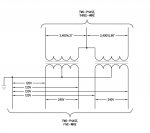does that mean that 3 phase has six legs?
also, the table in the answer key only shows 3 lines (which I assumed are 3 legs)
I guess it is tough to understand since the book doesn't explain 2-phase I think at all
Think of a phase as a line on an oscilloscope, not as a wire.
When you see a single phase on a scope, you will see one sine wave that represents the voltage difference between two conductors.
When you see three phase, you will see three sine waves. One will be the voltage difference between conductor A and B, a second, B and C, and a third, A and C. In three phase, each phase shares a conductor with another phase.
In two phase, there will be two sine waves, One will be the voltage between conductors A and B, and the second phase will be the voltage between conductors C and D. In two phase, conductors are not shared.
In the early days of AC, two phase was present in many areas, as it has advantages over single phase in a factory type setting, especially when it comes to motors. Multi-phase motors are simpler and more reliable than single phase motors.
Then, a few guys decided to try Tesla's 3 phase concept for factory motors. 3 phase has an advantage over 2 phase in that only three wires are needed. 3 phase took off, and the rest is history, except the part about the guy that was the most responsible for the popularity of 3 phase had a falling out with his partners, and never got the credit he deserved. Ironically, factory workers for decades knew his name.....it was on their Thermos bottles. Stanley Thermos bottles.


